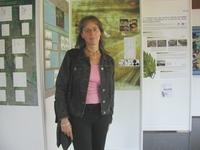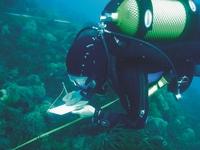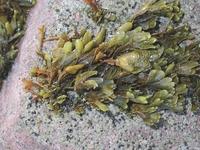Estibaliz Berezibar: "I want to know if global warming can be studied in the sight of algae"

I want to investigate whether climate change - the tempering of air and water - can be seen or not in Portuguese coastal algae. I want to know if it is possible or not to analyze global warming in view of the alga distribution limits.
For this purpose I have taken as a starting point a doctoral thesis carried out in Portugal in the years 50 and 60, F. The great work of the French Ardré. I want to do the same as him, but 50 years later and compare the results.
F. F. Ardré chose 24 areas of Portugal, from Galicia to Huelva, and conducted a local study of its algae. The conclusion is that in Portugal there are many distribution limits. For example, in the north of Portugal, above all, there are numerous algae of cold waters. Other algae, despite being located in the Mediterranean, do not reach the north of Portugal.
Therefore, among other things, I want to see if those limits have gone or not to the north.
I studied marine sciences in Las Palmas. Then I worked in the cultivation of algae and in the Biota project, also in the field of algae. After nine years in Las Palmas, I came to Euskal Herria. Then I received an offer to work in a laboratory in Portugal, from the hand of my current boss. The job offer was three months, but I have been there for almost four years. As you can see, it has been a coincidence.
However, with what is researched and learned so far, we cannot deny that it is a special place in terms of algae.
In the north we find algae of cold waters and in the subtropical south, both Mediterranean and own of Madeira or Canaries.

The Mediterranean, for example, is very special. For example, the Mediterranean and the Atlantic are very different. The first is much hotter in summer and much colder in winter, the water is more salty, there is hardly any tide... it is a special place compared to the Atlantic. And Portugal is located, say, in the center of both.
In Portugal, in addition, there is the phenomenon called "up-welling" on the western coast. The wind coming from the northeast propels the upper waters towards the sea and the low waters rise. That is why the waters of Galicia and Portugal are so cold. This water is very rich in food, so there are many algae, it is a very productive coast.
Yes. I am studying the benthic marine macroalgae of the Portuguese coast, which are attached to the substrate. The vast majority of macroscopic algae are benthic. Microscopic algae are not visible. But when the water looks green, for example, they are there. Phytoplankton is formed by several microscopic algae.
Benthic algae, like all plants, need light and food. Benthic macroalgae are glued to the ground. Therefore, if they are stuck and need light, they cannot live very deeply. Its limit is the depth to which the light arrives, which occurs on the coast.
In addition, food is obtained through processes (inorganic compounds) that take place in rivers and/or coasts.
The open sea, in principle, is poor water. Therefore, it has few microscopic algae and more light is introduced. An oasis may occur under water.

In this case I have studied all the previous bibliographic work -- research by Ardré and other works -- and I have been able to know what has been done so far. Then, we examined the funds from all over Portugal and collected hundreds of samples. In general, we have made stays of 15 days in one and the other. Always taking into account the specific conditions of each place. In my case, for example, I have only selected live tides for research. I have recently started to analyze samples, identify species, etc. Visual, with magnifier and microscope, respectively. And then, this information must be worked, that is, if each species is found or not in the same place where it has been found, or if there has been or no change.
On the Portuguese coast have appeared a lot of new species not mentioned above. I have only been identifying these species for about two months and have already found 20 new species. As has been said, Portugal is an unseen place, little studied. It is not surprising, therefore, to obtain new information. In addition to the 24 areas studied by Ardré, I have analyzed other areas, with about 35 points across the coast, both intertidal and submarines.
Globally yes. There are many people who work on it. Especially some algae are highly studied, including: Porphyra (used for sushi), Gelidium (for agar-agar) and Fucus (used in dietetics). We have analyzed mainly those that have a specific application for people.
But, in general, there are very few books on algae. There are specific jobs but there is no general algae work. On the contrary, there are many books about fish. Groups of local researchers have gradually formed in Galicia, Asturias, Madrid, Andalusia, Catalonia, Basque Country, etc. As a result, the knowledge of algae is increasing, and many floristic catalogues are currently being developed in the peninsula. In Portugal there is a lot of work to do.
Knowing the marine vegetation is essential. It is very interesting. And today there are many researchers who work on this task.


Buletina
Bidali zure helbide elektronikoa eta jaso asteroko buletina zure sarrera-ontzian











